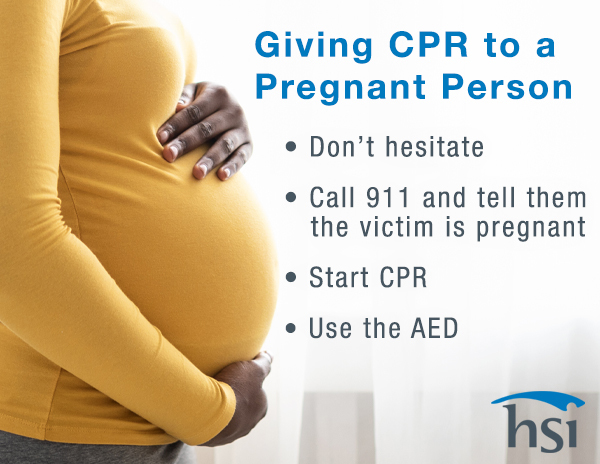Giving CPR to a Pregnant Person: What You Need to Know

What do I do if the victim is pregnant in the event of cardiac arrest? This is a common question that Emergency Care Instructors hear when covering cardiopulmonary resuscitation (CPR) and automated external defibrillator (AED) topics. Some bystanders might feel hesitant to intervene out of fear of harming the baby or mother. This topic is important to discuss to help reduce barriers to bystander CPR and AED use.
Just like with other cardiac arrest victims, it’s better to provide care than to do nothing at all. CPR and defibrillation steps are the same—you'll perform CPR and use an AED as you would with non-pregnant adults.
Here’s some information to better understand how a woman’s body adapts during pregnancy and special considerations to take when providing emergency care.
Heart Health During Pregnancy
Pregnancy causes many anatomical and physiological changes that can create an extra strain on a woman’s body.
During pregnancy, there’s an increased need for blood flow within the mother’s body. Cardiac output (or blood volume) rises 30% to 50% to meet the needs of both the mother and growing baby. Additionally, a woman’s heart rate may increase by 15 to 20 beats per minute throughout her pregnancy.
With the heart working overtime and other influencing factors, many health conditions can arise during pregnancy.
Maternal Cardiac Arrest Data
Sudden cardiac arrest can happen to anyone at any time, including during pregnancy. Data on maternal deaths and cardiac arrests suggests cardiac arrest occurs in 1 out of 12,000 admissions for delivery in the United States. But that number doesn’t include women who experience cardiac arrest outside of hospital settings throughout different stages of pregnancy.
While maternal cardiac arrests are considered rare events, they can happen for many reasons. If a pregnant woman were to collapse in front of you, would you know what to do?
CPR and AED Use on Pregnant Women
Bystanders can become more hesitant to perform CPR when the person is pregnant. Even more so when using an AED. But it’s important to remember that without providing these life-saving measures, the mother and the baby will likely not survive.
So, act fast and with confidence. Don’t delay chest compressions or defibrillation for a pregnant person.
- Call 911. Let the emergency dispatchers know the woman is pregnant, so first responders can be prepared to respond accordingly when they arrive on the scene.
- Start immediate CPR. There is no scientific evidence to support changing your hand placement for chest compressions on a pregnant woman. If you aren’t trained, give compression-only CPR by pushing hard and fast at the center of the chest.
- Use the AED. The sooner an AED shock is provided as directed, the better the chance for survival. Follow the normal steps for operating the AED. To be clear, defibrillation shock will not harm the baby and is considered safe in each stage of pregnancy.

If the person starts breathing, moving, or reacting in other ways, place the person on their left side for better blood flow.
For more information about performing CPR and the use of an AED in a specific situation, take a CPR, AED and First Aid class near you.
Learn more about CPR, AED, and First Aid training programs for your organization and how to become a CPR instructor with HSI.



